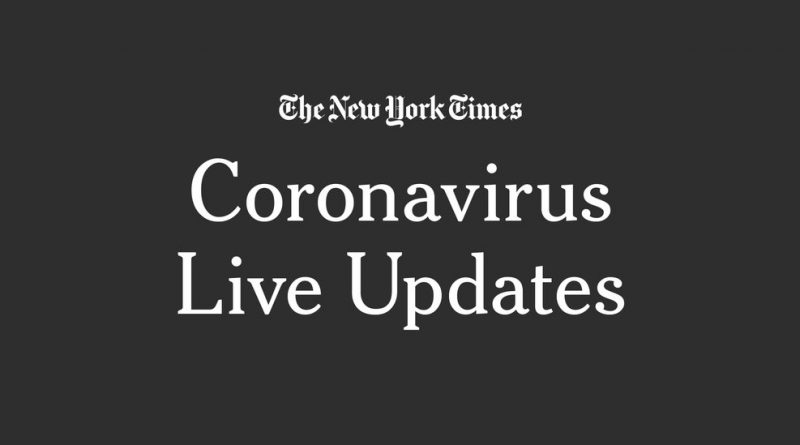Live Coronavirus Updates: White House Looks to Cut Billions From Testing Plan
The White House pushes to eliminate billions from a relief proposal drafted by Senate Republicans.
The Trump administration has balked at providing billions of dollars to fund coronavirus testing and shore up federal health agencies as the virus surges across the country, complicating efforts to reach agreement on the next round of pandemic aid.
Senate Republicans had drafted a proposal that would allocate $25 billion in grants to states for conducting testing and contact tracing, as well as about $10 billion for the Centers for Disease Control and Prevention and about $15 billion for the National Institutes of Health, according to a person familiar with the tentative plans. They had also proposed providing $5.5 billion to the State Department and $20 billion to the Pentagon to help counter the virus and potentially distribute a vaccine at home and abroad.
But in talks over the weekend, administration officials instead pushed to zero out the funding for testing and for the nation’s top health agencies, and to cut the Pentagon funding to $5 billion, according to another person familiar with the discussions. The people asked for anonymity to disclose private details of the talks, which were first reported by The Washington Post.
The administration’s position presents an added complication to negotiations between Democrats, who are pressing for a more expansive aid bill, and Republicans, who hope to unveil a narrower opening offer for virus relief as early as this week.
On Saturday, more than 61,000 coronavirus cases were announced in the United States, according to a New York Times database. On Thursday, the country set a record with new cases topping 75,600, the 11th time in the past month that the daily record had been broken.
As the United States struggles to contain surging caseloads and an increasing death toll, the Food and Drug Administration on Saturday issued its first emergency approval for a testing approach that allows multiple samples to be screened together.
The decades-old method has been used to test for the virus in China, Germany, Israel and Thailand. In Nebraska, a state scientist found a loophole that allowed him to circumvent federal prohibitions on the method.
The U.S. military has used the technique for diseases at its bases worldwide since it first tested for syphilis in the 1940s.
The approach expands the number of people who can be tested without requiring the use of additional materials and staffing.
“Sample pooling becomes especially important as infection rates decline and we begin testing larger portions of the population,” the F.D.A. chief, Stephen Hahn, said in a statement.
The number of weekly tests reported nationwide has increased to more than five million in early July from about one million in early April, according to data collected by the Covid Tracking Project. At the same time, the rate of positive tests, which had steady declined from late April to early June, has been increasing in recent weeks, the data show.
After nine months of waiting for surgery, Ruth Fawcett’s knee muscles wasted away, causing her joint to come loose in its socket and leaving her unable to walk without assistance.
“They’ve just stopped doing surgery for cases that they call nonlife-threatening and when they start again, they will probably have to prioritize the most urgent cases,” she said, taking a deep sigh.
Ms. Fawcett, 82, a jewelry designer from the northwestern county of Cumbria, is one of nearly four million people in England on the National Health Service waiting list for routine hospital treatments.
With hospitals operating at pandemic-reduced capacity, the waiting list could soar to 10 million people by the end of the year, according to the N.H.S. Confederation, which represents hospitals and other health care providers, though the service rejects that estimate.
“They won’t tell me where I am on the list, or how urgent they consider my case to be,” Ms. Fawcett said. “I can hardly walk. My knee just wobbles about and if I don’t use my two walking sticks, I will fall. It’s very scary.”
In other news around the world:
-
The leader of Hong Kong, Carrie Lam, said on Sunday that the city recorded more than 100 new cases in the past 24 hours, the most since the pandemic took hold in late January. “The situation is very serious and there is no sign of it coming under control,” Ms. Lam said. Hong Kong suspended nonessential government services and told most civil servants to work from home from this week.
-
Face coverings will be required in Melbourne, Australia’s second-largest city, whenever people leave home, officials there said on Sunday, citing a recent increase in cases. The requirement will take effect on Wednesday. Violations could result in a fine of 200 Australian dollars, or roughly $140.
-
Chinese officials are battling a growing outbreak in the far western Xinjiang region, the center of the country’s broad crackdown on predominantly Muslim ethnic minorities. Thirty confirmed infections have been reported in its capital, Urumqi, since Thursday, 13 of them on Sunday; there are an additional 41 asymptomatic infections.
-
European Union leaders agreed to go back to the negotiating table on Sunday after two long, difficult days of talks during which they have been trying to bridge differences over how to distribute and oversee a stimulus plan that would send 750 billion euros, or about $840 billion, into the bloc’s economies.
Transit leaders in cities including Seattle, Los Angeles and Miami warn they need billions of dollars in aid to prevent their systems from collapsing, as pandemic precautions and the economic crisis continue to take a toll and as the first round of congressional aid is quickly drying up.
The cratering of the economy has put nearly 11 percent of Americans on the unemployment rolls and closed about 66,000 small businesses, dealing a blow to the sales and income tax revenues that many cities and states use to fund transit agencies.
The mix of forces has been brutal: Ridership has plummeted 90 percent on some of the nation’s biggest systems, including in New York and the San Francisco Bay Area. Transit agencies across the country are projected to rack up close to $40 billion in budget shortfalls, dwarfing the $2 billion loss inflicted by the 2008 financial crisis.
Midsize agencies have not been spared. Denver’s transit agency is cutting service by 40 percent. In New Orleans, where 14 percent of its transit workers have tested positive for the virus, fare revenue has dropped by 45 percent. Cleveland, where unemployment levels have reached 23 percent, will lose 14 percent of its revenue by 2021.
According to the head of San Francisco’s network, this could plunge systems into a “transit death spiral,” where cuts to service and delayed upgrades make public transit a less convenient option for the public, which prompts further drops in ridership and further cuts, until a network eventually collapses.
Ben Fried, a spokesman for the TransitCenter, a philanthropic foundation that supports nationwide transit overhaul, said, “If the emergency response is not robust, and robust over a prolonged period of time, these agencies will be looking at long term cuts to service.”
“It’s just really scary to think about where transit systems and transit riders are going to end up,” he added.
As countries told people to stay home to slow the spread of the virus, doctors in neonatal intensive care units were noticing something strange: Premature births were falling, in some cases drastically.
It started with doctors in Denmark and Ireland. Each team, unaware of the other’s work, found that during the lockdowns, premature births — especially the earliest, most dangerous cases — had plummeted. When they shared their findings, they heard similar anecdotal reports from other countries.
They do not know what caused the drop in premature births, and can only speculate as to the factors in lockdown that might have contributed. But further research might help doctors, scientists and parents-to-be understand the causes of premature birth and ways to prevent it, which have been elusive until now. Their studies are not yet peer reviewed, and have been posted only on preprint servers. In some cases the changes amounted to only a few missing babies per hospital. But they represented significant reductions from the norm, and some experts in premature birth think the research is worthy of additional investigation.
“These results are compelling,” said Dr. Denise Jamieson, an obstetrician at Emory University’s School of Medicine in Atlanta.
According to the Centers for Disease Control and Prevention, babies born premature, especially before 32 weeks, are at higher risk of vision and hearing problems, cerebral palsy and death.
Joan Murray had been home with Covid-19 for about a week when she ran into trouble. She had a fever of 103 degrees and chills that sent shivers up and down her spine. Her oxygen levels were dropping, and the tightness in her chest felt “as if somebody had bound up my lungs with string.”
But the 77-year-old, a retired registered nurse who lives alone in Westbury, N.Y., was adamant that she wanted to fight the illness at home.
So Northwell Health, which has cared for thousands of coronavirus patients in its network of facilities in New York State, sent a nurse manager to Ms. Murray’s home in May to do an assessment.
Ms. Murray was dehydrated and in need of supplemental oxygen. Within hours, she was hooked up to an intravenous line, set up in her bedroom to replenish her fluids. A phlebotomist in an N95 mask came to draw blood, an oxygen machine was delivered to her home, and Ms. Murray was prescribed a powerful blood thinner to prevent clots.
So-called wraparound home care services were created, on the fly, by Northwell Health to deal with the surge in coronavirus cases that New York experienced this spring. Now this model may help relieve health systems in the Sun Belt and other parts of the United States, where rising numbers of cases are putting extraordinary pressure on hospitals, filling intensive care units and sending providers scrambling to hire extra nurses and secure medical supplies.
How to plan a vacation in the midst of a pandemic.
Traveling these days requires lots of research, precision planning and a willingness to play by new and very stringent rules.
Reporting was contributed by Emily Cochrane, Roni Caryn Rabin, Ceylan Yeginsu, Tiffany May, Pranshu Verma, and Elizabeth Preston.
Shared From Source link Breaking News



